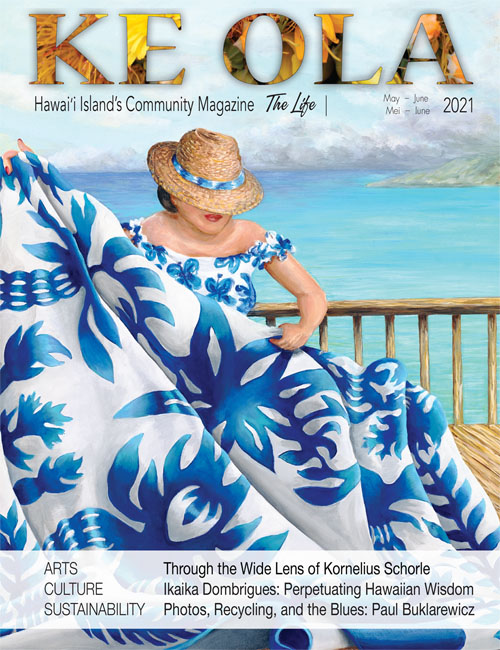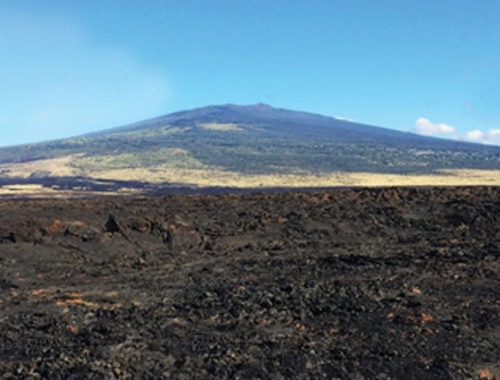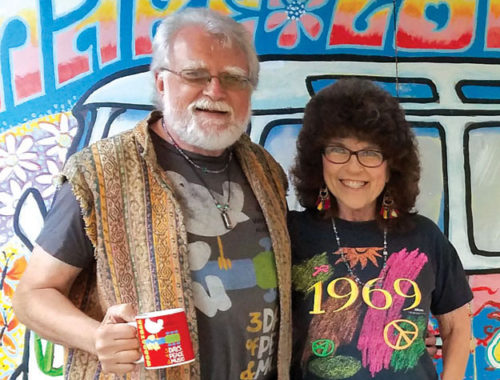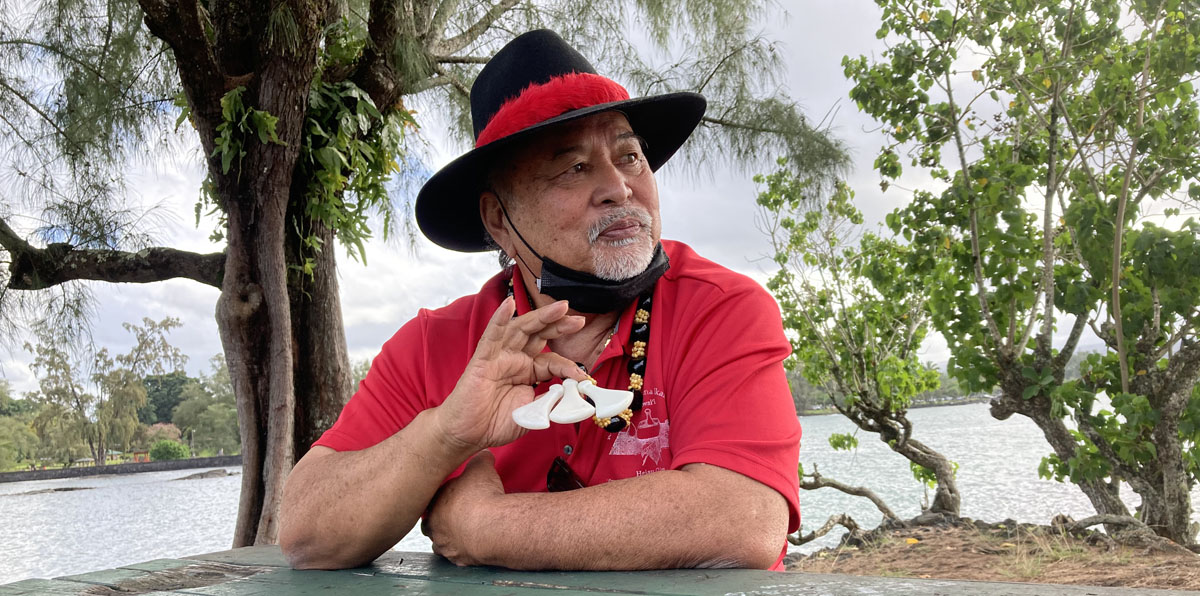
Ikaika Dombrigues: Perpetuating Sacred Hawaiian Wisdom

By Mālielani Larish
Wearing a black hat brimmed by a brilliant red feather hakupapa (hat band), Kahuna Nui O Pali Tu Po Paki O Lono Ikaika Dombrigues is as calm as Hiloʻs Mokuola (Coconut Island) on which he sits.
Ikaika is a high priest of the order of Lono and also a descendant of Lono (the Hawaiian god of peace, agriculture, rain, and healing). The inner strength that Kahuna Ikaika embodies comes from his deep connection to the spiritual teachings of his ancestors, who have guided him to master the healing arts of Ho‘omana (pre-contact Hawaiian religion and beliefs). As the priests of ancient Hawai‘i, kahuna were revered for their intimate knowledge of the spirit world and nature. Although the word kahuna in Hawaiian can be used to denote an expert in any profession, according to Kahuna Ikaika, the title means “keepers of the huna mana [secret energy]” when applied to Hawaiian priests.
Ikaika’s mission is to preserve, protect, and perpetuate the sacredness of the teachings of the kahuna, helping guide individuals of all backgrounds, and native Hawaiians in particular, towards healing and wholeness.
The True Source of Healing
Even though he has reached the highest kahuna ranking, Ikaika remains humble because he is aware that the Creator is the true source of all power and ability.
“I don’t use the word ‘healer’ because the source is the healer. I’m just a vessel,” he says.
Ikaika knows that spirituality can be a complex topic, filled not only with landmines of cross-cultural misunderstanding and historical layers of suppression and abuse, but also with personal experiences of doubt and diminished faith. When someone comes to him, he tries to look at what caused the person to forget their true identity. He asks, “What separated them—what separated their spiritual side from their physical side?” Fearless and direct, he helps people confront the big questions: “Who are you? Why are you here? I’m helping you to become who you are,” he says.
Pule (prayer) is at the heart of his work. “I don’t know all the answers, but I’m going to ask to get the answers, and where do I get the answers?” He raises his eyes, points to heaven and says, “Up there.”
Before someone meets Ikaika in person, the ancestral spirits that guide him will talk to the guardian spirits of the person who he is going to meet. In this way, Ikaika already has insights into the energy of the forthcoming meeting, and he intuits the wisdom that the person needs to hear.

Ikaika has been trained to know the difference between positive and negative energies. Fortunately, there is plenty of help on his side. Once, when he met a Cherokee elder from Arizona at a conference, she looked in his eyes and said, “You walk with thousands.”
Ikaika teaches that we have the power to flip the switch and flood our life with positivity. He observes that nowadays, there is so much negativity in the world that having this tool is essential to bring us to a space of clarity.
People from all over seek Ikaika out, but he can be elusive. He laughs when he says that he is busier now that he is retired than when he was on the clock. In 1986, even while he was working full-time, Ikaika began conducting classes and workshops on traditional Hawaiian healing on all the major islands. Today he teaches workshops through Hui Mālama Ola Nā ‘Ōiwi, Hawai‘i Islandʻs Native Hawaiian health care system. He also provides private consultations and serves as Po‘okela of Hawai‘i Island and as a chair of the Native Hawaiian Healing Kupuna Council under Papa Ola Lokahi.
Since Mokuola has been a healing pu‘uhonua (place of refuge) for thousands of years, it is the perfect place for Ikaika to meet with people. In ancient times, it was graced by a magnificent heiau (temple) complex, and Hawaiians came to the island for healing, ceremonies, and forgiveness of transgressions of the kapu (prohibition) system. In order to earn the permission to step foot on the island, Hawaiians had to swim around it first. Ikaika observes that the kapu which protected the island as a sacred place was broken when a bridge was built to connect Mokuola with the main island. This bridge has been wiped out multiple times by several tsunamis over the decades since it was first built.
Chosen by the Ancestors
Becoming a kahuna is not simply a matter of inheritance and training; the ancestors and the gods choose you and clearly show you that this is your destiny. You must be native Hawaiian and born in Hawai‘i. The Kahuna order is very strict and filled with rituals, kapu, and protocol.
Ikaika’s spiritual journey began as a young boy when his ancestors guided him to meet his hanai (adopted) grandfather, Kahuna Nui Pali Tu Po Paki O Ta Matahiti Sam Ho‘opi‘i Lono, who was the owner and caretaker of Kane‘ohe Valley on O‘ahu. When Ikaika slept in the heiau of the valley, Kahuna Lono would ask him what he experienced during the night. Ikaika shared that he had heard chanting, nose flutes, pahu drums, and people walking around him. Kahuna Lono simply said, “Good.” In time, Ikaika came to realize that the ancestors were showing him that he was meant to learn the traditions of the kahuna.

As he continued to study under his hanai grandfather, it was always the ancestors who made the call as to when Ikaika was ready to advance to the next level. It takes over 40 years to become a kahuna, requiring 12 years in each area of discipline.
After the passing of his hanai grandfather, the ancestors led him to his hanai father on Maui, Kahuna Pule Kawika Ka‘alakea, who helped him deepen his understanding of the spiritual healing power of prayer. In 1974, Kahuna Pule Ka‘alakea was miraculously healed of tuberculosis that the doctors deemed fatal—all thanks to pule.
In addition, Ikaika’s ancestors have guided him to learn from Kahuna Lapa‘au Harry Mitchell of Keanae, Maui; Kupuna Anake Abbie Napeahi of Hilo; Ho‘oponopono and Anakala, Sonny Kinney of Hilo; and many other teachers.
Wisdom of Ho‘omana
Ikaika’s inherent gifts and training have enabled him to learn five healing disciplines of Ho‘omana: La‘au Lapa‘au, Ho‘oponopono, La‘au Kahea, Ma‘iola, and Lomilomi Ha Ha.

La‘au Lapa‘au is perhaps the most well-known branch of Hawaiian healing. It combines the power of pule with medicines made from plants and minerals from the land and sea. He regularly gives islandwide workshops on La‘au Lapa‘au in five ‘apanas (districts) of the island: Hilo, Waimea, Kona, Kohala, Ka‘u, and Pahoa. He tells the workshop participants, “Look in your communities; there are elders that know the medicine. Go and seek their knowledge.” He guides students to learn the plant names, what they look like, and where to find them. Then the students are ready to learn the remedies.
An added benefit of practicing La‘au Lapa‘au is that it encourages people to spend time in nature, something that Ikaika says is very important for overall wellbeing. He notes that scientific findings have supported the health benefits of grounding to Mother Earth through walking barefoot, bathing in the sea, and using metals and minerals. “This island lives and breathes,” he says. “It teaches you.”
Ho‘oponopono, another branch of traditional Hawaiian healing, has gained popularity around the world. It is a process of reconciliation used to resolve a problem that, according to Ikaika, should not have happened. The last three healing techniques that Ikaika practices are divinely bestowed gifts that cannot be taught. La‘au Kahea is faith healing, Ma‘iola is a spiritual process, and Lomilomi Ha Ha is a spiritual technique that combines Lomilomi massage with the power to remove internal blockages without operation.
A Strong Foundation
One of the foundations that Kahuna Ikaika repeatedly returns to is “nana i ke kumu, nana i ke kumu hana, nana i ke kumulipo,” which translates to “look unto the Source, look to the Source within you, and look to the kumulipo,” the cosmological chant written by one of Ikaika’s ancestors. Ikaika says that from the kumulipo comes the understanding that man was made as a perfect specimen of ke akua o ka lani (god of heaven), and that our responsibility is to take care of the land and all of the gifts that have been given to us for our survival and enjoyment.
Ikaika wears a pendant of three white poi pounders as a symbol of this three-fold teaching. Additionally, the poi pounders represent the life-giving force within food and the kahuna gift of transforming plants and minerals into medicine.
“You have to make sure that your own foundation is pono [righteous] before you can help others,” Kahuna Ikaika says, and grounding oneself in “nana i ke kumu, nana i ke kumu hana, nana i ke kumulipo” creates that strong foundation.
“We do have gifts from ke akua o ka lani. Through Him, we have the power to help each other and ourselves.” Indeed, on Mokuola, Kahuna Ikaika continues in the tradition of the ancient kahuna who presided here, guiding people to look to the Source that is within and without. ❖
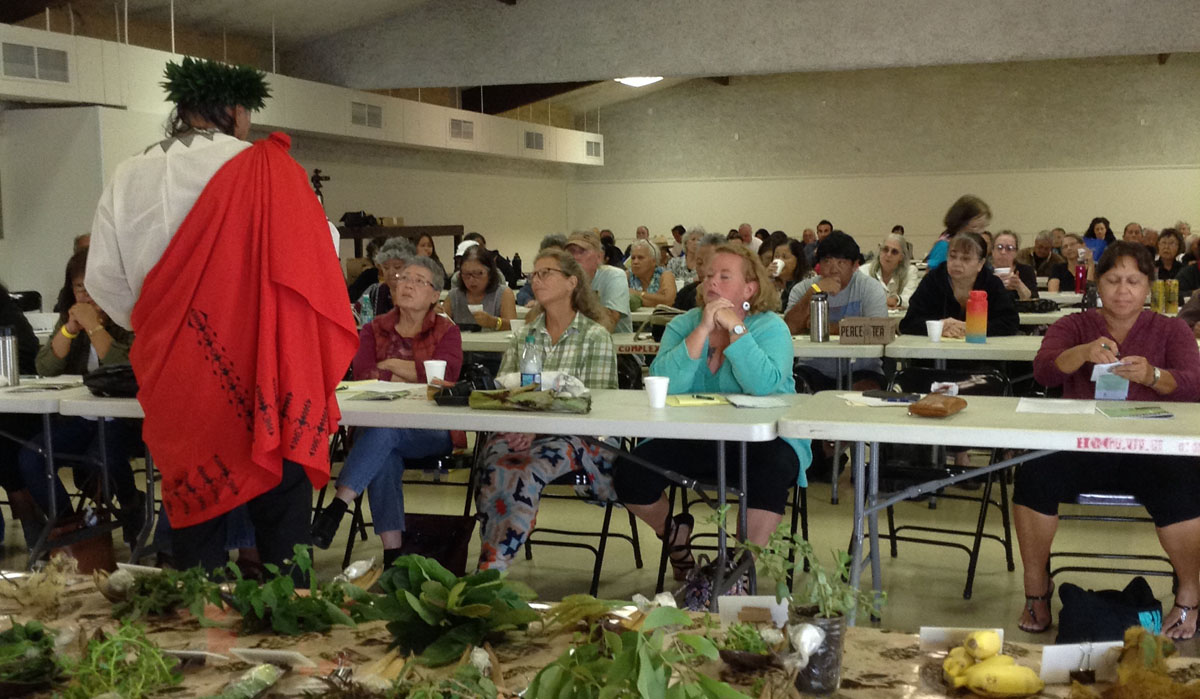
Editor’s note: Kahakō (macrons) have been omitted. ‘Okina (glottal stop) in the name Moloka‘i is also omitted; both per Ikaika’s request.
For more information: hmono.org/la‘au-lapa‘au/
